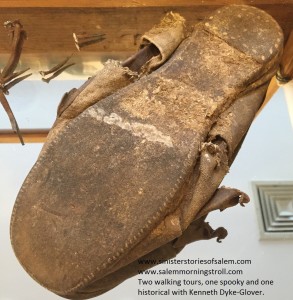Just a few miles from Salem, Massachusetts were a few old curiosities of daily colonial life displayed in a glass topped curio table. Among the items was a single brown leather shoe. Although the items were interesting to me I had not at first sight understood the real purpose they once served the person who left them behind. Each day I try to read something related to my work as a tour guide in Salem, Massachusetts. I began to read articles about apotropaic magic or counter magic in the 17th century. Apotropaic is from the Greek which means to ward off evil. In fact many cultures use every day objects to ward off evil and protect their homes and households from jealous eyes and imagined supernatural threats conjured up by active imaginations.
I learned about the English folk tradition of counter magic employed by colonists to protect their homes from witchcraft, malefic things and devils. I reconsidered the brown leather shoe, soled with wooden pegs that was found walled and hidden away above the front door of a first period Essex County home. The location where the object was found pointed strongly to its re-use as an object of counter magic. I would casually describe what was done with the shoe as witchcraft to protect someone from witchcraft which is witchcraft. I’m mostly certain that the Essex county family responsible for the shoe had no real involvement in the Salem witch trials beyond a general concern to not be caught up in the accusations. The question is this. Was the person who hid these items in a wall and others items under floor boards in fact using counter magic? More than likely they were.
I asked an historian in Salem what she thought about this shoe. This historian had been one of the team members of the Gallows Hill Project, a group of respected historians who were assembled to confirm the location where the hangings of the Salem witch trials took place. She thought the shoe based on its location was used for counter magic and even pointed out that the wooden pegs fastening the sole placed the items manufacture in the years between 1600 and 1800.
In the English folkway tradition, the shoe of a deceased person is employed to trap that persons spirit in place so that the spirit serves to protects the home. Let me point out that only one shoe is used and not both because otherwise the spirit would be free to metaphorically in my words to put one foot in front of the other and walk away. New England ministers like Mr. Cotton Mather and Mr. Samuel Parris believed that all magic employed the involvement of the devil and imperiled the person practicing it. Imagine the consequences to the person given to superstition and this little sorcery if he had come under suspicion of witchcraft and had also been discovered to have walled up this item. Bridget Bishop who did lose her life in the Salem hysteria stood accused of making poppets, another item of counter magic. To be clear, she could not have made the ones she was accused of having. These were described in the record as “puppets” stuffed with “pig brustle” hidden in the cellar walls of her downtown Salem home.
Come on an historical tour with me to learn more about this story. www.salemwalkingtours.com or www.salemwalkingtours.com
Written by Kenneth Glover


Recent Comments